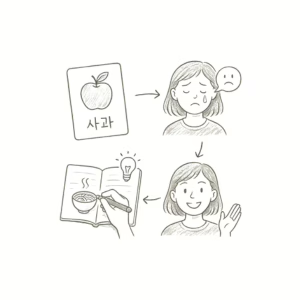When we think about learning a new language like Korean, most people imagine hours of memorizing vocabulary, repeating grammar structures, and drilling flashcards. But what if I told you there’s a smarter, gentler way to learn—without forcing yourself to memorize anything?
The Problem with Rote Memorization
Traditional language learning methods rely heavily on rote memorization. You repeat the same words until they stick in your brain, but often forget them the next week. This method is not only boring but also ineffective for long-term retention. It disconnects you from the why and the feeling behind the words.
And if your brain is already tired or emotionally overwhelmed, memorizing things becomes even harder.
The Secret: Visuals and Emotions
Language is not just about words—it’s about meaning, context, and feeling. Korean especially is rich in emotional nuance, cultural expressions, and visual cues in its writing system (Hangul).
By tapping into your brain’s natural preference for images and emotions, you can bypass the stress of memorization and feel your way into fluency.
Here’s how:
1. Use Image Associations
Instead of writing down the Korean word for “apple” (사과) and repeating it 50 times, look at a picture of a juicy apple with the word written underneath. Even better, use a flashcard app with visuals, or draw your own cute apple and write 사과 beside it.
👉 Why it works: Your brain stores images faster than raw data. When you see 사과 next to a real apple, your brain forms a natural connection. It becomes effortless.
2. Connect Words to Emotions
Let’s say you’re learning the word “슬프다” (to be sad). Don’t just read the definition. Close your eyes. Remember a time when you felt sad. Connect that emotion to the word.
Or watch a short Korean drama clip where someone cries and hear them say “슬퍼…” That emotional moment sticks with you far more than a dictionary definition ever could.
👉 Why it works: Emotional memory is powerful. If a word made you laugh, cry, or feel surprised, you’re much more likely to remember it.
3. Create Your Own Memory Triggers
Let’s say you’re learning the word for “teacher” – 선생님 (seonsaengnim). Make up a story in your head:
“Seon” sounds like “sun” ☀️
“Saeng” reminds you of “sang” (someone singing) 🎵
So imagine a teacher singing under the sun!
Even if it’s silly, that’s the point. The sillier, the better.
👉 Why it works: Personal stories + funny images = long-term memory storage.
4. Color, Draw, and Doodle Your Notes
Turn your Korean notes into mini artworks. Use colors to highlight verbs, emotions, or food vocabulary. Doodle a bowl of ramen next to “라면,” or sketch a sleepy face next to “졸리다” (to be sleepy).
👉 Why it works: This engages your creative brain, making studying more fun and meaningful.
5. Speak with Your Face, Not Just Your Tongue
When you say Korean words, use facial expressions and gestures. If you say “행복해요” (I’m happy), smile. If you say “아파요” (It hurts), touch your head and frown.
👉 Why it works: Physical movement and emotion lock in meaning. You’re not just speaking—you’re performing the feeling behind the word.
Final Thoughts
If you’ve struggled with language learning in the past, maybe it wasn’t your fault. Maybe the system was wrong.
You don’t need to memorize hundreds of words like a robot. You can learn Korean naturally—just like a child does—through images, feelings, and play.
The next time you sit down to study, don’t open a vocabulary list. Open your heart, your imagination, and your senses. Let Korean come alive inside you.

Comments